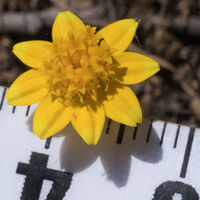goldfields
genus Lasthenia
Member of
tarweeds and allies (tribe Madieae)
sunflower family (family Asteraceae)
dicots (class Magnoliopsida)
flowering plants (subphylum Angiospermae)
Except for extremely rare examples that I don't expect to encounter, there are no other wild species of this genus in the bay area.
Key features:
- phyllaries free or partially fused (and what percent is fused)
- number of phyllaries
- leaf shape
- ray length
- pappus present or not, color, opacity (pappus in flower, in seed)
Distinguishing goldfields often requires examining the pappus. The pappus takes the place of the calyx/sepals in the disk flowers. If the flower is in bloom, the pappus is typically shorter than the disk corolla, so to see it you’ll need to bend the ray flowers down with a thumbnail, pull the flower head apart, or perhaps pull out one disk flower (which may bring the pappus with it or leave it attached to the ovary. I need to test that idea.) Once the flower goes to seed and the corollas fall off, the pappus is much easier to see and often looks like a dandelion’s seed pod.
See also hillside daisies (genus Monolopia), which have narrow (but not linear) wedge-shaped leaves that are quite hairy.
phyllaries free
maritime goldfields
Lasthenia maritima
- phyllaries free, generally > 6
- mid-cauline leaves generally pinnately lobed
- ray 1–3 mm
- pappus awns ≥ 4, rarely 0
- very rare
coastal goldfields
Lasthenia minor
- phyllaries free, generally > 6
- mid-cauline leaves generally pinnately lobed
- ray 4–8 mm
- pappus awns 2–3(4) or 0
- rare
small-ray goldfields
Lasthenia microglossa
- phyllaries free
- phyllaries generally ± 4
- the whole flower head is narrow and has extremely short ray flowers
- Mt. Diablo
phyllaries ± fused
contra costa goldfields
Lasthenia conjugens
- phyllaries ± fused, fused portion < ½ length
- leaves entire to pinnately lobed
- scattered in low-lying areas of the East Bay
2 observed taxons / 6 unobserved taxons / 1 key
Locations: Months: For more details, use advanced search.
Chris’s observations: 25 (6 are research grade)
Taxon info: iNaturalist – Calflora – Jepson eFlora – FNA
Bay Area species: iNaturalist – Calflora

